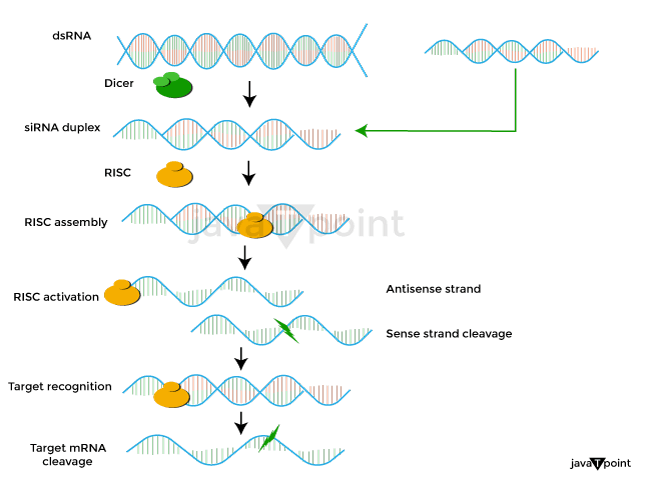Gene SilencingGene silencing, also known as gene suppression or gene regulation, is the process of lowering or blocking a specific gene's expression or activity. It is a key mechanism used by cells to control gene expression and is important for a variety of biological processes, including development, differentiation, and the response to environmental cues. Post-transcriptional, epigenetic, and transcriptional mechanisms, among others, can be used to silence genes at different phases of development. 
History of Gene SilencingGene silence has been the subject of fascinating research for several decades, which has produced a wealth of ground-breaking findings and fresh understanding of the intricate mechanisms behind gene control. Gene silencing is the process of selectively decreasing a gene's expression so that its protein isn't produced. Numerous biological systems depend on this phenomenon, which has significant implications for both basic research and therapeutic application. Let's look at the key turning points in gene silencing history. The concept of gene silencing first emerged with Barbara McClintock's discovery of "transposons" or "jumping genes" in the 1970s. She discovered that some genetic elements had the capacity to move throughout the genome, altering the expression of genes that were close by. However, the molecular mechanisms underlying gene silencing weren't fully known until the 1990s. Andrew Fire and Craig Mello's discovery of RNA interference (RNAi) in 1990 was the first big development in the field. They demonstrated how specific gene silencing by double-stranded RNA molecules was possible in the nematode Caenorhabditis elegans. For making this important discovery, they were awarded the Nobel Prize in Physiology or Medicine in 2006. Prior to the discovery of RNAi, there was no known method for studying gene silencing. Subsequent research done in the late 1990s and early 2000s shed light on the mechanisms of RNAi. It was revealed that double-stranded RNA molecules are used to make small interfering RNAs (siRNAs), which are synthesised by the enzyme Dicer. These siRNAs then instruct a protein complex called the RNA-induced silencing complex (RISC) to target messenger RNAs (mRNAs) and either destroy them or suppress their translation. After its discovery, scientists quickly realised that RNAi had great promise as a potent tool for examining gene activity. The RNAi-mediated gene silencing technique allowed scientists to silence specific genes with great precision while monitoring the phenotypic changes that resulted. A deeper understanding of how genes function has been made possible by new insights into the roles that several genes play in growth, disease, and other biological processes. Our understanding of DNA methylation, a different sort of gene silencing, has also advanced. DNA methylation, which involves adding a methyl group to the DNA molecule, suppresses gene expression. DNA methylation patterns have been revealed to be crucial for regulating gene expression in health and disease, and they may be heritable. A lot of knowledge about the genetic origins of diseases has been gained as a result of the advancement of genome sequencing technologies and the conclusion of the Human Genome Project in 2003. This prompted researchers to look at gene silencing as a potential therapeutic strategy. Scientists have begun to develop methods for introducing siRNAs or other gene-silencing agents into cells in an effort to treat a variety of hereditary disorders, such as cancer, viral infections, and neurological ailments. Recent advances in the field of gene silencing include significant advancements in the development of gene-editing tools like CRISPR-Cas9. This innovative method makes precise gene silencing or activation possible, bringing up a myriad of possibilities for both research and therapeutic usage. Mechanism of Gene SilencingGene silencing can occur at different levels, including transcriptional, post-transcriptional, and epigenetic, and it is achieved through a variety of mechanisms. 
At the level of DNA transcription, a process known as transcriptional gene silencing (TGS) takes place. One of the primary processes in TGS is DNA methylation, which involves adding a methyl group to the DNA molecule, typically at cytosine residues. DNA methylation can repress gene expression by preventing proteins and transcription factors required for gene activation from binding with DNA. Methylated DNA attracts proteins that entice histone modifiers, resulting in a compact chromatin structure that prevents gene transcription. Histone modification also contributes to the silencing of transcriptional genes. DNA is wound around a protein structure known as chromatin, which is made up of histones. Histone protein modifications such as acetylation, methylation, phosphorylation, and ubiquitination can have an impact on gene expression. For instance, histone deacetylation, which entails removing acetyl groups from histones, promotes a constricted chromatin structure that restricts gene transcription. The regulation of gene expression occurs after transcription, and is known as post-transcriptional gene silencing (PTGS). Small RNA molecules such microRNAs (miRNAs) and small interfering RNAs (siRNAs), which are involved in PTGS, serve an important role. These little RNA molecules, created from larger precursor molecules, comprise the RNA-induced silencing complex (RISC). The RISC complex attaches to messenger RNA (mRNA) molecules and blocks their complementary sequences, causing the degradation or prevention of translation into proteins. In order to prevent the production of the incorrect protein, gene expression is essentially silenced. The term "epigenetic gene silencing" refers to modifications to DNA and the proteins that are related to it that may be passed down and have a big effect. One well-known example of epigenetic gene silencing in female animals is the X-chromosome inactivation, where one of the two X chromosomes in each cell is arbitrarily silenced. This approach ensures that male and female genes are expressed equally by effectively silencing one of the X chromosomes in females. Another technique for silencing genes is known as RNA interference (RNAi), which is initiated by double-stranded RNA molecules. These molecules might emerge naturally from many reasons, like viral infections, or they might get into cells by experimental ways. When the enzyme Dicer identifies double-stranded RNA, it produces small interfering RNAs (siRNAs). The integration of these siRNAs into the RISC complex leads to the degradation or inhibition of translation of the complementary mRNA molecules. In addition to the approaches mentioned above, other techniques can result in gene silence. As an illustration, nucleosome remodelling complexes can alter the location of nucleosomes, which has an impact on DNA access and may influence gene expression. Chromatin looping and other three-dimensional genome organising mechanisms can also regulate a gene's level of activity by drawing certain DNA sections to or isolating them from regulatory elements. The precisely controlled methods of gene silencing can be affected by a wide range of factors. For instance, specific proteins called transcriptional repressors have the ability to bind to the regulatory regions of genes and draw enzymes that alter DNA or histones, silencing the related gene. Other factors like chromatin modifiers and non-coding RNAs can also have an impact on gene expression and gene silencing. Gene silencing can have a significant effect in both normal and abnormal biological processes. In the course of normal development, gene silence helps establish and maintain cell differentiation and identity. During the development of the embryo, for example, some genes are selectively activated or suppressed to promote the formation of specific cell types and tissues. A variety of illnesses, including cancer, neurological disorders, and genetic syndromes, have been linked to the onset and development of gene silence. Aberrant gene silence in cancer may lead to the inactivation of tumour suppressor genes, which typically regulate cell proliferation and prevent the growth of tumours. This decrease in gene expression could be brought on by a number of different processes, including histone modifications, aberrant miRNA synthesis, DNA hypermethylation, and others. By contrast, gene silencing techniques that result in the overexpression of specific genes have the potential to worsen cancer. Therapeutic strategies that aim to regulate gene expression for therapeutic purposes have been developed as a result of research and understanding of gene silencing. Using the natural mechanisms of gene silence carried out by small RNA molecules, RNA interference (RNAi) is one such tactic. Genes that contribute to illness, such as those involved in cancer, hereditary disorders, and viral infections, can be targeted and silenced using RNA interference. The development of novel and targeted treatments has a lot of potential with this approach. Advantages of Gene Silencing
Disadvantages of Gene Silencing
Applications of Gene SilencingSome of the key applications of gene silencing are:
Next TopicGenes Structure
|
 For Videos Join Our Youtube Channel: Join Now
For Videos Join Our Youtube Channel: Join Now
Feedback
- Send your Feedback to [email protected]
Help Others, Please Share









